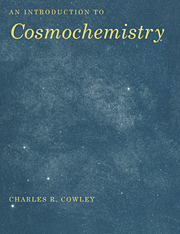Book contents
- Frontmatter
- Contents
- Foreword
- 1 Overview
- 2 Minerals: An Introduction to the Nomenclature and Chemistry
- 3 A Brief Introduction to Petrology
- 4 A Résumé of Thermodynamics and Statistical Mechanics
- 5 Condensation Sequences and the Geochemical Classification of the Elements
- 6 The Theory of the Bulk Composition of the Planets
- 7 Meteorites and the Standard Abundance Distribution (SAD)
- 8 An Introduction to Isotope Geology with an Emphasis on Meteorites
- 9 Some Concepts from Nuclear Physics
- 10 Energy Generation in Stars and Nucleosynthesis
- 11 Atomic and Molecular Spectra
- 12 The Analysis of Stellar Spectra
- 13 The Chemistry of Stars and Stellar Systems
- 14 Cold, Non-stellar Material in Galaxies
- 15 Emission-Line Regions and their Chemical Abundances
- 16 Abundances of the Elements in Galaxies
- Appendix
- References
- Index
Foreword
Published online by Cambridge University Press: 05 June 2012
- Frontmatter
- Contents
- Foreword
- 1 Overview
- 2 Minerals: An Introduction to the Nomenclature and Chemistry
- 3 A Brief Introduction to Petrology
- 4 A Résumé of Thermodynamics and Statistical Mechanics
- 5 Condensation Sequences and the Geochemical Classification of the Elements
- 6 The Theory of the Bulk Composition of the Planets
- 7 Meteorites and the Standard Abundance Distribution (SAD)
- 8 An Introduction to Isotope Geology with an Emphasis on Meteorites
- 9 Some Concepts from Nuclear Physics
- 10 Energy Generation in Stars and Nucleosynthesis
- 11 Atomic and Molecular Spectra
- 12 The Analysis of Stellar Spectra
- 13 The Chemistry of Stars and Stellar Systems
- 14 Cold, Non-stellar Material in Galaxies
- 15 Emission-Line Regions and their Chemical Abundances
- 16 Abundances of the Elements in Galaxies
- Appendix
- References
- Index
Summary
My career as a professional astronomer was some 15 years old when it first became necessary for me to learn something of the new developments in the solar system. At that time, in the mid-1970's, I was about as ignorant of the solar system as one trained in astronomy could possibly be. Worse than that, I had an attitude typical of many astronomers today. Because the field was old, I thought it was dull and uninteresting! Nevertheless, when it became necessary for me to give an introductory course in solar system astronomy, I thought I must try to understand what all the fuss over moon rocks was all about.
Moon rocks are not so terribly different from terrestrial rocks, and so I began to read an introductory geology text. Soon, I was making trips to the building next door to visit the Geology Department. I became an amateur geologist, and a rockhound. On automobile trips I would stop at various rock formations, and bash off samples with a rock hammer. These samples were typically shown to a geologist, sometimes in a nearby university or college, sometimes back at Michigan.
The experience of becoming an amateur geologist was immensely broadening. Not only did I become a great fan of planetary science, but I began to be interested in other areas of astronomy that had never particularly appealed to me. Eventually, I began to realize that there was a single theme behind all of these endeavors – the history of matter.
- Type
- Chapter
- Information
- An Introduction to Cosmochemistry , pp. xi - xiiPublisher: Cambridge University PressPrint publication year: 1995

